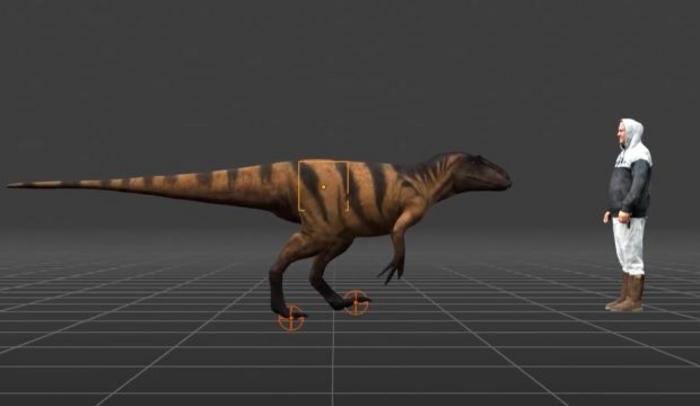
A recent breakthrough in paleontological research has unveiled the dynamic life of a theropod dinosaur that roamed East Asia more than 120 million years ago. Led by Dr. Anthony Romilio of the University of Queensland’s Dinosaur Lab, a team of researchers has digitally reconstructed the Phoenix Trackway—a remarkable sequence of fossilized footprints spanning 70 meters in China’s Sichuan Province. This trackway, comprising 80 consecutive footprints, represents the longest documented path left by a bipedal predator in the region, offering an unprecedented glimpse into the dinosaur’s movement and behavior during the Early Cretaceous period.
For decades, fossilized bones have been the primary source of knowledge about extinct species. However, footprints and trackways provide critical behavioral context that bones alone cannot convey. The Phoenix Trackway is a rare and invaluable record, capturing a fleeting moment of a dinosaur’s journey frozen in stone. By employing cutting-edge digital modeling and imaging analysis, Dr. Romilio’s team has transformed these fossilized footprints into a detailed animation, allowing scientists to trace the dinosaur’s gait, pace changes, and directional choices in extraordinary detail.
The research involved meticulous measurements of the trackway’s footprint spacing, depth, and orientation. These data points enabled researchers to estimate the dinosaur’s physical attributes with impressive accuracy. The reconstructed predator was approximately 1.13 meters tall at the hip and weighed close to 292 kilograms. Its movement, reconstructed step-by-step, revealed a walking speed of roughly 5.3 kilometers per hour, comparable to a brisk human walk. Notably, it momentarily accelerated into a light trot before returning to its steady pace, suggesting a purposeful and controlled mode of locomotion rather than aimless wandering.
What distinguishes this study is the integration of digital technology with traditional paleontological techniques. Historically, the logistical challenges of field measurement have limited in-depth analyses of extensive trackways like the Phoenix Trackway. The team circumvented these challenges through comprehensive imaging analysis, digitally capturing the site’s morphology and footprint metrics. This method not only preserves the site’s details permanently but also allows for repeated virtual examinations and biomechanical simulations, significantly advancing the scope of behavioral paleontology.
The Phoenix Trackway had long been shrouded by local folklore attributing its origins to a mythical phoenix. Scientific analysis, however, dispels these legends, identifying the footprints as those of a large predatory dinosaur akin in size to Yutyrannus, a feathered tyrannosauroid of similar geochronology. This contextual placement enhances our understanding of dinosaur diversity and ecosystem dynamics during the Early Cretaceous in East Asia, an interval marked by dramatic evolutionary transitions.
By digitally animating the dinosaur’s locomotion, the researchers gained extraordinary insights into its biomechanics. The step patterns and stride lengths suggest a sophisticated neuromuscular control system enabling the animal to modulate speed tactically, likely in response to environmental stimuli or predatory demands. This nuanced understanding challenges earlier, simplistic notions of dinosaur movement and highlights the complexity of their behavioral repertoires.
Additionally, the study reinforces the value of interdisciplinary collaboration in paleontology. Co-authored by Dr. Lida Xing from the China University of Geosciences, the project underscores the synergy of field expertise, digital imaging, and biomechanical modeling. Such partnerships facilitate robust interpretations of fossil evidence, bridging gaps between remote field sites and advanced computational laboratories.
Moreover, this research exemplifies how digital preservation can revolutionize paleontological data management. Fossil sites are vulnerable to natural erosion and human interference. By capturing ultra-precise digital replicas, scientists ensure that these invaluable traces of life’s past remain accessible for future generations, regardless of physical site degradation. This archival potential enhances reproducibility in scientific inquiry and democratizes data sharing across institutions worldwide.
This investigation also opens new avenues for exploring predator-prey interactions and habitat utilization in extinct ecosystems. Understanding gait and locomotion patterns enables paleobiologists to infer hunting strategies, energy expenditure, and environmental navigation. These reconstructions thus contribute to more holistic paleoecological models, revealing how ancient creatures lived, moved, and interacted in their habitats.
Ultimately, the digital analysis of the Phoenix Trackway not only rejuvenates a long-lost narrative of a prehistoric predator’s purposeful stride but also amplifies the transformative potential of technology in uncovering life’s ancient stories. The convergence of imaging analysis, biomechanics, and paleontology continues to push the boundaries of what can be known about creatures that vanished millions of years ago, turning static stone impressions into vivid tales of motion and survival.
Subject of Research: Dinosaur locomotion and behavior through digital reconstruction of fossilized trackways.
Article Title: A Digital Analysis of the ‘Phoenix Trackway’ at the Hanxi Cretaceous Dinosaur Tracksite, China
News Publication Date: 3-May-2025
Web References:
University of Queensland Dinosaur Lab: https://dinosaurs.group.uq.edu.au/
Research article DOI: http://dx.doi.org/10.3390/geosciences15050165
Reconstruction video: https://app4.vision6.com.au/ch/50178/4tm94/2909872/ofDsqIilaNT7AJ9H63DHKHVkVU3lHDL7fHReiq_Q.html
References:
Romilio, A., & Xing, L. (2025). A Digital Analysis of the ‘Phoenix Trackway’ at the Hanxi Cretaceous Dinosaur Tracksite, China. Geosciences, 15(5), 165. https://doi.org/10.3390/geosciences15050165
Image Credits: Dr. Anthony Romilio, University of Queensland
Keywords: Dinosaur trackway, digital reconstruction, Early Cretaceous, Phoenix Trackway, biomechanics, paleontology, imaging analysis, theropod locomotion
Tags: bipedal predator behaviordigital modeling in paleontologydigital reconstruction of fossilsdinosaur movement analysisDr. Anthony Romilio research teamEarly Cretaceous period behaviorfossilized footprint significancepaleontological breakthroughsPhoenix Trackway footprintsprehistoric life evolutionSichuan Province dinosaur trackstheropod dinosaur research





